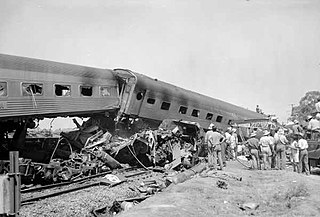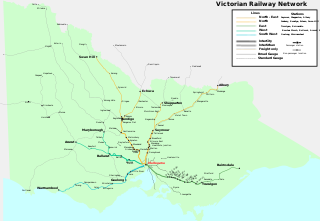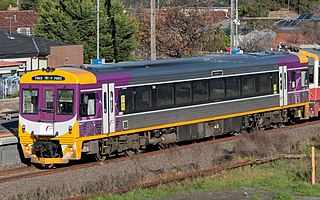
Sunshine railway station is located on the Sunbury line in Victoria, Australia, serving the western Melbourne suburb of the same name.

The Violet Town rail accident, also known as the Southern Aurora disaster, was a railway accident that occurred on 7 February 1969 following the incapacitation of the driver of one of the trains, near the McDiarmids Road crossing, approximately 1 km south of Violet Town, Victoria, Australia. The crash resulted in nine deaths and 117 injuries.

V/Line is a statutory authority that operates regional passenger train and coach services in the Australian state of Victoria. It provides passenger train services on five commuter lines and eight long-distance routes from its major hub at Southern Cross railway station in Melbourne. It also provides bus services across Victoria and into New South Wales, the Australian Capital Territory and South Australia. In addition, V/Line is responsible for the maintenance of much of the Victorian freight and passenger rail network outside of the areas managed by Metro Trains Melbourne and the Australian Rail Track Corporation.

Rail transport in the Australian state of Victoria is provided by a number of railway operators who operate over the government-owned railway lines. The network consists of 2,357 km of Victorian broad gauge lines, and 1,912 km of standard gauge freight and interstate lines; the latter increasing with gauge conversion of the former. Historically, a few experimental 762 mm gauge lines were built, along with various private logging, mining and industrial railways. The rail network radiates from the state capital, Melbourne, with main interstate links to Sydney and to Adelaide, as well as major lines running to regional centres, upgraded as part of the Regional Fast Rail project.
The Charfield railway disaster was a fatal train crash which occurred on 13 October 1928 in the village of Charfield in the English county of Gloucestershire. The London, Midland and Scottish Railway (LMS) Leeds to Bristol night mail train failed to stop at the signals protecting the down refuge siding at Charfield railway station. The weather was misty, but there was not a sufficiently thick fog for the signalman at Charfield to employ fog signalmen. A freight train was in the process of being shunted from the down main line to the siding, and another train of empty goods wagons was passing through the station from the Bristol (up) direction.

The V/Line VLocity, sometimes called the VLocity 160, is a diesel multiple unit train built by Bombardier Transportation and later Alstom in Dandenong for V/Line, the regional rail operator in the Australian state of Victoria. Continuously in production since 2003, the VLocity is the highest-speed train in the V/Line fleet, with a top speed of 160 km/h (99 mph). As of February 2024 with set 114 entering service, 112 3-car sets are in revenue service, 2 collision damaged sets are in storage, and 25 more are under construction on the current confirmed orders.

Ballarat railway station is located on the Serviceton line in Victoria, Australia. It serves the city of Ballarat, and opened on 11 April 1862 as Ballarat West. It was renamed Ballarat in 1865.
The Deniliquin railway line is a broad-gauge railway line serving northwestern Victoria, Australia. The line runs from the New South Wales town of Deniliquin into Bendigo, before turning south-southeast towards Melbourne, terminating in Docklands near the central business district. It is a major trunk line both for passenger and freight trains, with many railway lines branching off from it.

The C class was a mainline goods locomotive of the 2-8-0 'Consolidation' type that ran on the Victorian Railways between 1918 and 1962. Although its original design had some key shortcomings, a number of improvements were made over the class' long career on the VR, many of which were subsequently applied to other locomotive classes on the system.
There have been a number of train accidents on the railway network of Victoria, Australia. Some of these are listed below.
The railways of New South Wales, Australia have had many incidents and accidents since their formation in 1831. There are close to 1000 names associated with rail-related deaths in NSW on the walls of the Australian Railway Monument in Werris Creek. Those killed were all employees of various NSW railways. The details below include deaths of employees and the general public.

The Kerang train accident occurred on 5 June 2007 at about 13:40 AEST in the Australian state of Victoria, approximately 6 kilometres (3.7 mi) north of the town of Kerang in the state's northwest, and 257 kilometres (160 mi) north-northwest of the city of Melbourne.

The Sprinter is a diesel railcar built by A Goninan & Co in Broadmeadow, NSW for V/Line between 1993 and 1995.
The New Deal for Country Passengers was a timetable introduced on 4 October 1981 in Victoria, Australia which revolutionised the provision of country passenger railway services in that state. Thirty-five little-used passenger stations were closed, rolling stock utilisation was improved, and new rolling stock introduced. The timetable and associated service changes resulted in an average patronage growth of 8.7% per year, from 3 million in 1981 to 5.6 million passengers in 1990/91.

The Victorian Railways' (VR) Royal Trains operated to transport members of the Royal Family on their numerous tours of Australia on the Victorian rail network. The same carriages were also used for a number of vice-regal trains for the Governor-General of Australia and the Governor of Victoria. The last Royal Train ran in 1988.

The mainline passenger locomotives, later classified as B class, ran on the Victorian Railways (VR) between 1862 and 1917. They used a 2-4-0 wheel arrangement, which provided greater traction on the new, more heavily graded Geelong–Ballarat railway and the Melbourne-Bendigo-Echuca railway, as opposed to the 2-2-2 arrangement previously selected for the relatively level Geelong line. The B class locomotives are regarded as the first mainline VR motive power, and were highly successful in passenger operations.
The Slough rail accident happened on 16 June 1900 at Slough railway station on the Great Western Main Line when an express train from London Paddington to Falmouth Docks ran through two sets of signals at danger, and collided with a local train heading for Windsor & Eton Central. Five passengers were killed; 35 were seriously injured, and 90 complained of shock or minor injuries
This article lists significant fatal, injury-only, and other accidents involving railway rolling stock, including crashes, fires and other incidents in the Australian state of South Australia. The first known incident in this list occurred in 1873 in Smithfield.
On 3 February 2003, a Comeng electric multiple unit train rolled away from Broadmeadows station in Melbourne, Australia, before it ran for nearly 17 kilometres (11 mi) out of control without a driver and eventually crashed into another train about to depart Spencer Street station. Train controllers attempted several times to stop or redirect the train, but were limited in their ability to intervene, instead being forced to alter the route of other trains to avert a more serious collision. Eleven people on board the stationary train were injured; authorities did not know until after the crash if any passengers were on board the runaway. An investigation identified driver error as the cause of the accident, but the runaway event prompted significant debate about the role of government authorities and private operators in ensuring safety and reliability on the Melbourne rail network.
The Salt Clay Creek railway disaster was one of Australia's first railway accidents involving multiple fatalities. It occurred on the evening of 25 January 1885, when a mail train from Albury to Sydney failed to negotiate a flooded creek, around 5 km from Cootamundra. Seven people were killed and dozens seriously injured.















